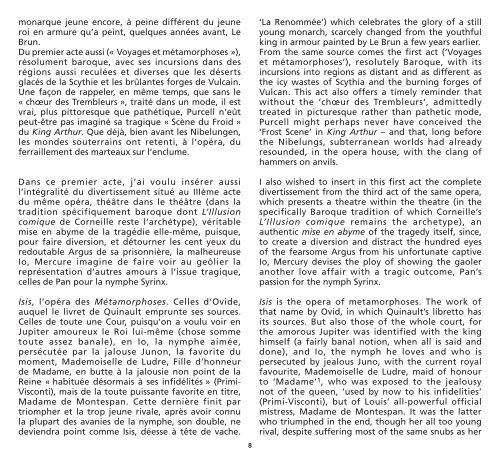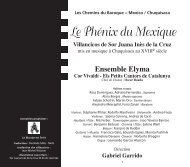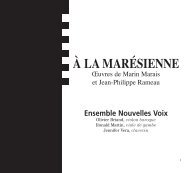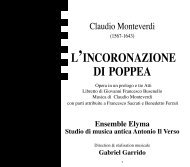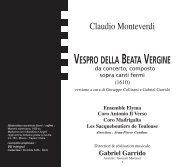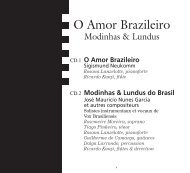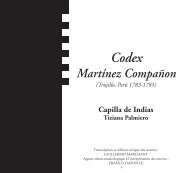Un voyage au cÅur des opéras de Jean-Baptiste Lully
Un voyage au cÅur des opéras de Jean-Baptiste Lully
Un voyage au cÅur des opéras de Jean-Baptiste Lully
Create successful ePaper yourself
Turn your PDF publications into a flip-book with our unique Google optimized e-Paper software.
monarque jeune encore, à peine différent du jeuneroi en armure qu’a peint, quelques années avant, LeBrun.Du premier acte <strong>au</strong>ssi (« Voyages et métamorphoses »),résolument baroque, avec ses incursions dans <strong><strong>de</strong>s</strong>régions <strong>au</strong>ssi reculées et diverses que les désertsglacés <strong>de</strong> la Scythie et les brûlantes forges <strong>de</strong> Vulcain.<strong>Un</strong>e façon <strong>de</strong> rappeler, en même temps, que sans le« chœur <strong><strong>de</strong>s</strong> Trembleurs », traité dans un mo<strong>de</strong>, il estvrai, plus pittoresque que pathétique, Purcell n’eûtpeut-être pas imaginé sa tragique « Scène du Froid »du King Arthur. Que déjà, bien avant les Nibelungen,les mon<strong><strong>de</strong>s</strong> souterrains ont retenti, à l’opéra, duferraillement <strong><strong>de</strong>s</strong> marte<strong>au</strong>x sur l’enclume.Dans ce premier acte, j’ai voulu insérer <strong>au</strong>ssil’intégralité du divertissement situé <strong>au</strong> IIIème actedu même opéra, théâtre dans le théâtre (dans latradition spécifiquement baroque dont L’Illusioncomique <strong>de</strong> Corneille reste l’archétype), véritablemise en abyme <strong>de</strong> la tragédie elle-même, puisque,pour faire diversion, et détourner les cent yeux duredoutable Argus <strong>de</strong> sa prisonnière, la malheureuseIo, Mercure imagine <strong>de</strong> faire voir <strong>au</strong> geôlier lareprésentation d’<strong>au</strong>tres amours à l’issue tragique,celles <strong>de</strong> Pan pour la nymphe Syrinx.‘La Renommée’) which celebrates the glory of a stillyoung monarch, scarcely changed from the youthfulking in armour painted by Le Brun a few years earlier.From the same source comes the first act (‘Voyageset métamorphoses’), resolutely Baroque, with itsincursions into regions as distant and as different asthe icy wastes of Scythia and the burning forges ofVulcan. This act also offers a timely remin<strong>de</strong>r thatwithout the ‘chœur <strong><strong>de</strong>s</strong> Trembleurs’, admittedlytreated in picturesque rather than pathetic mo<strong>de</strong>,Purcell might perhaps never have conceived the‘Frost Scene’ in King Arthur – and that, long beforethe Nibelungs, subterranean worlds had alreadyresoun<strong>de</strong>d, in the opera house, with the clang ofhammers on anvils.I also wished to insert in this first act the completedivertissement from the third act of the same opera,which presents a theatre within the theatre (in thespecifically Baroque tradition of which Corneille’sL’Illusion comique remains the archetype), an<strong>au</strong>thentic mise en abyme of the tragedy itself, since,to create a diversion and distract the hundred eyesof the fearsome Argus from his unfortunate captiveIo, Mercury <strong>de</strong>vises the ploy of showing the gaoleranother love affair with a tragic outcome, Pan’spassion for the nymph Syrinx.Isis, l’opéra <strong><strong>de</strong>s</strong> Métamorphoses. Celles d’Ovi<strong>de</strong>,<strong>au</strong>quel le livret <strong>de</strong> Quin<strong>au</strong>lt emprunte ses sources.Celles <strong>de</strong> toute une Cour, puisqu’on a voulu voir enJupiter amoureux le Roi lui-même (chose sommetoute assez banale), en Io, la nymphe aimée,persécutée par la jalouse Junon, la favorite dumoment, Ma<strong>de</strong>moiselle <strong>de</strong> Ludre, Fille d’honneur<strong>de</strong> Madame, en butte à la jalousie non point <strong>de</strong> laReine « habituée désormais à ses infidélités » (Primi-Visconti), mais <strong>de</strong> la toute puissante favorite en titre,Madame <strong>de</strong> Montespan. Cette <strong>de</strong>rnière finit partriompher et la trop jeune rivale, après avoir connula plupart <strong><strong>de</strong>s</strong> avanies <strong>de</strong> la nymphe, son double, ne<strong>de</strong>viendra point comme Isis, déesse à tête <strong>de</strong> vache.8Isis is the opera of metamorphoses. The work ofthat name by Ovid, in which Quin<strong>au</strong>lt’s libretto hasits sources. But also those of the whole court, forthe amorous Jupiter was i<strong>de</strong>ntified with the kinghimself (a fairly banal notion, when all is said anddone), and Io, the nymph he loves and who ispersecuted by jealous Juno, with the current royalfavourite, Ma<strong>de</strong>moiselle <strong>de</strong> Ludre, maid of honourto ‘Madame’ 1 , who was exposed to the jealousynot of the queen, ‘used by now to his infi<strong>de</strong>lities’(Primi-Visconti), but of Louis’ all-powerful officialmistress, Madame <strong>de</strong> Montespan. It was the latterwho triumphed in the end, though her all too youngrival, <strong><strong>de</strong>s</strong>pite suffering most of the same snubs as her


